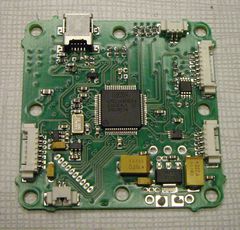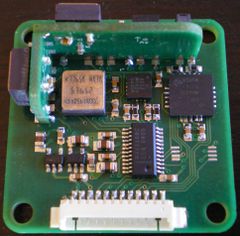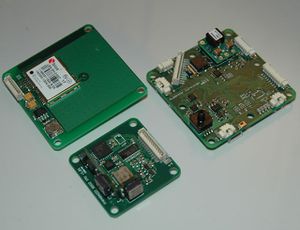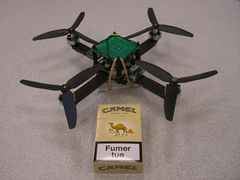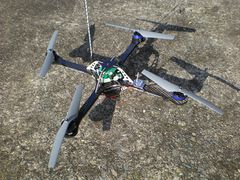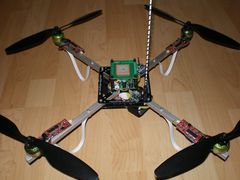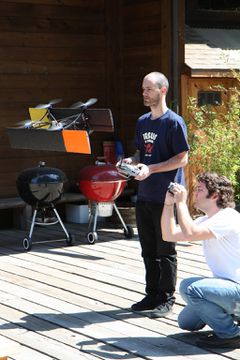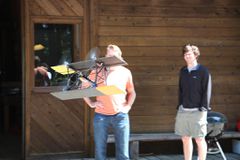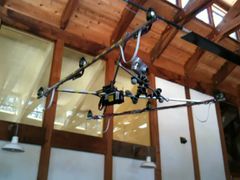Difference between revisions of "Booz"
m (→Simulator) |
|||
| (27 intermediate revisions by 7 users not shown) | |||
| Line 1: | Line 1: | ||
<div style="float: right; width: 30%"><categorytree style="float:right; clear:right; margin-left:1ex; border: 1px solid gray; padding: 0.7ex;" mode=pages>Autopilots</categorytree></div> | |||
<div style="float: right; width: 40%">[[Image:booz_logo.jpg|480px|right]]</div> | |||
== Overview == | == Overview == | ||
<p>Booz is an extension of Paparazzi to VTOLs. At the current stage of the project, the system provides attitude stabilization, vertical guidance and automatic navigation. It is able to use | <p>Booz is an extension of Paparazzi to VTOLs. At the current stage of the project, the system provides attitude stabilization, vertical and horizontal guidance and automatic navigation. It is able to use Paparazzi flight plans and uses Paparazzi telemetry and datalink, which means all the Paparazzi ground segment applications are available( plotter, settings, gcs, etc...)</p> | ||
<p>The current | <p>The current avionics consist of 3 boards</p> | ||
[[Image:booz2_main.jpg|240px]] | [[Image:booz2_main.jpg|240px]] | ||
[[Image:booz2_imu.jpg|240px]] | [[Image:booz2_imu.jpg|240px]] | ||
| Line 8: | Line 10: | ||
* The main board, comprising power supply, a LPC2148 and a barometer. | * The main board, comprising power supply, a LPC2148 and a barometer. | ||
* The IMU board, comprising gyroscopes, accelerometers, magnetometers and a 16 | * The IMU board, comprising gyroscopes, accelerometers, magnetometers and a 16-bit ADC. | ||
* The GPS board, using a LEA-5H by ublox. | * The GPS board, using a LEA-5H by ublox. | ||
| Line 27: | Line 29: | ||
[[Image:booz2_a5.jpg|240px]] | [[Image:booz2_a5.jpg|240px]] | ||
== | == Simulator == | ||
Paparazzi features the advanced [[NPS]] simulator which can serve many purposes, from learning how to operate a vehicle to evaluating control or estimation algorithms. | |||
== Hardware == | == Hardware == | ||
| Line 44: | Line 44: | ||
more info in [[BoozPowerBoard]] | more info in [[BoozPowerBoard]] | ||
=== Booz GPS === | |||
more info in [[BoozGPSBoard]] | |||
=== IMU === | === IMU === | ||
| Line 61: | Line 64: | ||
=== Airframes === | === Airframes === | ||
One nice thing about quadrotors is that the mechanics being extremely simple, they can be build with very | One nice thing about quadrotors is that the mechanics being extremely simple, they can be build with very few tools. | ||
Booz mounting holes are compatible with | Booz mounting holes are compatible with popular of the shelf frames. | ||
more info in [[BoozAirframes]] | more info in [[BoozAirframes]] | ||
| Line 68: | Line 71: | ||
===Purchasing Hardware=== | ===Purchasing Hardware=== | ||
<p>There are now vendors offering Booz hardware, Please see the [http://paparazzi.enac.fr/wiki/Get_Hardware Get Hardware] page for details.</p> | <p>There are now vendors offering Booz hardware, Please see the [http://paparazzi.enac.fr/wiki/Get_Hardware Get Hardware] page for details.</p> | ||
== Hardware Test == | == Hardware Test == | ||
Booz comes with a number of simple test programs that you can use to validate a newly assembled board or learn how booz code works in case you want to extend it. | Booz comes with a number of simple test programs that you can use to validate a newly assembled board or learn how booz code works in case you want to extend it. | ||
more info in [[BoozHardwareTest]] | |||
== Software == | |||
=== Peripheral support === | |||
=== | {|border="1" cellspacing="0" style="text-align:center" cellpadding="6" | ||
!''Type #''!!''Model''!!''Booz''!!''Lisa/L'' | |||
|- | |||
|IMU ||Boozv1 ||yes||yes | |||
|- | |||
| ||crista ||yes||yes | |||
|- | |||
| ||mti || ? ||no | |||
|- | |||
| ||vn100 ||? ||no | |||
|- | |||
|RC ||PPM ||yes||no | |||
|- | |||
| ||spektrum ||yes||yes | |||
|- | |||
|Actuators ||asctec ||yes||yes | |||
|- | |||
| ||mkk ||yes||yes | |||
|- | |||
| ||servospwm|| 2 || 6 | |||
|- | |||
| ||CAN ||no || in progress | |||
|- | |||
|} | |||
== Sensors Calibration == | == Sensors Calibration == | ||
All | All the sensors needs to be calibrated in order to provide useful informations. The calibration process needs to be performed after the assembly of the vehicle is complete. | ||
**Note: The barometer on the Booz Main board is designed to work between -300 to 928 meters MSL. In this range it will create a zero offset, and then give 10cm resolution for 100 meters of altitude. BEWARE! if you fly above 100m the ADC will saturate. In addition, if you are someplace that is above 928 meters MSL the baro will not calibrate on boot, and will not output values. If you look at the RAW messages you will see that the BARO_RAW message reads 0 for both values. To fix the latter issue, the Value of R20 on the Main board can be changed to change the range. An example: If R20 is changes from a 560ohm to a 100ohm resistor, the new measurable range would be from -300 to 1800 meters. Because this changes the gain on the sensor it will also change the amount of altitude you can read from the ADC. For this case we reduce the amount to ~90 meters. | |||
more info in [[BoozSensorsCalibration]] | |||
== GCS notes == | |||
* If you set your ground modems for an interface rate different than 9600bps you need to add a flag to the "link" program on startup. In GCS if you use "Execute" you will see "link" is the first. You can click stop, then modify the command line by clicking in the text area. Add the -s flag with the baud rate you use. In my case 57600. So I use: -s 57600. Then click "Redo" and link will be restarted with the new flag and value (and you will start seeing messages and GCS wil populate). So you don't have to repeat this each time do "Save Session" and this will save the changes. | |||
== Airframe settings and Flight testing == | |||
* [[BoozAirframe]] | |||
== User Gallery == | |||
This page holds a list of current Booz users | |||
[[BoozUserList]] | |||
[[Category:Autopilots]] [[Category:Booz]] | |||
Latest revision as of 16:53, 20 June 2012
Overview
Booz is an extension of Paparazzi to VTOLs. At the current stage of the project, the system provides attitude stabilization, vertical and horizontal guidance and automatic navigation. It is able to use Paparazzi flight plans and uses Paparazzi telemetry and datalink, which means all the Paparazzi ground segment applications are available( plotter, settings, gcs, etc...)
The current avionics consist of 3 boards
- The main board, comprising power supply, a LPC2148 and a barometer.
- The IMU board, comprising gyroscopes, accelerometers, magnetometers and a 16-bit ADC.
- The GPS board, using a LEA-5H by ublox.
Additional Booz boards:
- The "power" board.
It flies on a variety of Quad-rotor platforms
and less common vehicles
Simulator
Paparazzi features the advanced NPS simulator which can serve many purposes, from learning how to operate a vehicle to evaluating control or estimation algorithms.
Hardware
Motor controllers
Booz is able to handle a number of quadrotor specific brushless motor controllers.
more info in BoozMotorControllers
Power board
The power board allows to switch power on and off on your vehicle as well as to make a clean wiring by avoiding wired Y
more info in BoozPowerBoard
Booz GPS
more info in BoozGPSBoard
IMU
Booz has support for its custom designed IMU as well as for Cloudcap Crista IMU
more info in BoozIMU
Autopilot
Current version of Booz autopilot is based on a lpc2148
more info in BoozAutopilot
A new version of the autopilot, based on a STM32 is in development
more info in Lisa
Airframes
One nice thing about quadrotors is that the mechanics being extremely simple, they can be build with very few tools. Booz mounting holes are compatible with popular of the shelf frames.
more info in BoozAirframes
Purchasing Hardware
There are now vendors offering Booz hardware, Please see the Get Hardware page for details.
Hardware Test
Booz comes with a number of simple test programs that you can use to validate a newly assembled board or learn how booz code works in case you want to extend it.
more info in BoozHardwareTest
Software
Peripheral support
| Type # | Model | Booz | Lisa/L |
|---|---|---|---|
| IMU | Boozv1 | yes | yes |
| crista | yes | yes | |
| mti | ? | no | |
| vn100 | ? | no | |
| RC | PPM | yes | no |
| spektrum | yes | yes | |
| Actuators | asctec | yes | yes |
| mkk | yes | yes | |
| servospwm | 2 | 6 | |
| CAN | no | in progress |
Sensors Calibration
All the sensors needs to be calibrated in order to provide useful informations. The calibration process needs to be performed after the assembly of the vehicle is complete.
- Note: The barometer on the Booz Main board is designed to work between -300 to 928 meters MSL. In this range it will create a zero offset, and then give 10cm resolution for 100 meters of altitude. BEWARE! if you fly above 100m the ADC will saturate. In addition, if you are someplace that is above 928 meters MSL the baro will not calibrate on boot, and will not output values. If you look at the RAW messages you will see that the BARO_RAW message reads 0 for both values. To fix the latter issue, the Value of R20 on the Main board can be changed to change the range. An example: If R20 is changes from a 560ohm to a 100ohm resistor, the new measurable range would be from -300 to 1800 meters. Because this changes the gain on the sensor it will also change the amount of altitude you can read from the ADC. For this case we reduce the amount to ~90 meters.
more info in BoozSensorsCalibration
GCS notes
- If you set your ground modems for an interface rate different than 9600bps you need to add a flag to the "link" program on startup. In GCS if you use "Execute" you will see "link" is the first. You can click stop, then modify the command line by clicking in the text area. Add the -s flag with the baud rate you use. In my case 57600. So I use: -s 57600. Then click "Redo" and link will be restarted with the new flag and value (and you will start seeing messages and GCS wil populate). So you don't have to repeat this each time do "Save Session" and this will save the changes.
Airframe settings and Flight testing
User Gallery
This page holds a list of current Booz users

